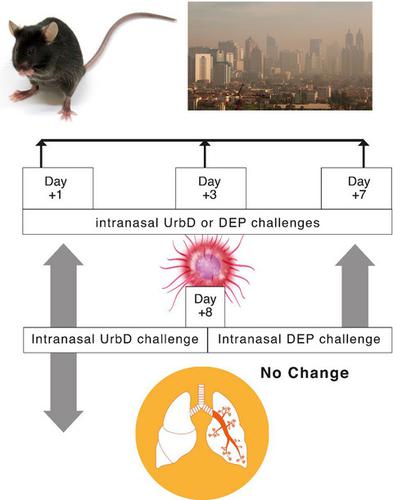当前位置:
X-MOL 学术
›
Immunol. Cell Biol.
›
论文详情
Our official English website, www.x-mol.net, welcomes your
feedback! (Note: you will need to create a separate account there.)
Different immune and functional effects of urban dust and diesel particulate matter inhalation in a mouse model of acute air pollution exposure
Immunology and Cell Biology ( IF 3.2 ) Pub Date : 2020-11-10 , DOI: 10.1111/imcb.12425 Odette M Shaw 1 , Gregory M Sawyer 1 , Roger D Hurst 2 , Hannah Dinnan 1 , Sheridan Martell 1
Immunology and Cell Biology ( IF 3.2 ) Pub Date : 2020-11-10 , DOI: 10.1111/imcb.12425 Odette M Shaw 1 , Gregory M Sawyer 1 , Roger D Hurst 2 , Hannah Dinnan 1 , Sheridan Martell 1
Affiliation

|
Increased global industrialization has increased air pollution resulting in 3 million annual deaths globally. Air pollutants could have different health effects, so specific models to identify the different immune effects are needed. The aim of this study was to determine the immune effects and lung function of acute exposure to two different pollution sources using a mouse model. Three intranasal challenges with either urban dust or diesel particulate matter resulted in significant (P < 0.001) immune cell infiltration into the lung, which was mostly because of an increased (P < 0.001) percentage of neutrophils. We found that exposure to either urban dust or diesel particulate matter significantly increased the lung tissue concentration of the neutrophil chemoattractant cytokine CXCL5 when compared with naïve controls. The urban dust challenge also significantly increased the concentration of the proinflammatory cytokine CCL20, but diesel particulate matter did not. The urban dust challenge significantly (P < 0.001) decreased tissue compliance and ability to stretch, and increased total airways constriction and lung tissue stiffness. In comparison, diesel particulate matter exposure slightly, but significantly (P = 0.022), increased tissue compliance and did not affect other lung function parameters. Although both urban dust and diesel particulate matter induced immune cell infiltration into the lung resulting in lung inflammation, their detrimental effects on cytokine production and lung function were quite different. This may be attributed to the variation in particulates that comprise these pollutants that directly interact with the lung tissue and consequently elicit a different functional response.
中文翻译:

城市灰尘和柴油颗粒物吸入对急性空气污染暴露小鼠模型的不同免疫和功能影响
全球工业化进程的加快加剧了空气污染,导致全球每年 300 万人死亡。空气污染物可能会产生不同的健康影响,因此需要特定模型来识别不同的免疫影响。本研究的目的是使用小鼠模型确定急性暴露于两种不同污染源的免疫效应和肺功能。城市灰尘或柴油颗粒物的三种鼻内攻击导致显着(P < 0.001)免疫细胞浸润到肺中,这主要是因为(P < 0.001) 中性粒细胞的百分比。我们发现,与初始对照相比,暴露于城市灰尘或柴油颗粒物显着增加了中性粒细胞趋化因子 CXCL5 的肺组织浓度。城市灰尘挑战也显着增加了促炎细胞因子 CCL20 的浓度,但柴油颗粒物没有。城市灰尘挑战显着(P < 0.001)降低了组织顺应性和伸展能力,并增加了总气道收缩和肺组织僵硬。相比之下,柴油颗粒物暴露轻微,但显着(P = 0.022),增加组织顺应性并且不影响其他肺功能参数。尽管城市灰尘和柴油颗粒物均诱导免疫细胞浸润到肺部导致肺部炎症,但它们对细胞因子产生和肺功能的不利影响却大不相同。这可能归因于包含这些污染物的颗粒物的变化,这些污染物直接与肺组织相互作用并因此引起不同的功能反应。
更新日期:2020-11-10
中文翻译:

城市灰尘和柴油颗粒物吸入对急性空气污染暴露小鼠模型的不同免疫和功能影响
全球工业化进程的加快加剧了空气污染,导致全球每年 300 万人死亡。空气污染物可能会产生不同的健康影响,因此需要特定模型来识别不同的免疫影响。本研究的目的是使用小鼠模型确定急性暴露于两种不同污染源的免疫效应和肺功能。城市灰尘或柴油颗粒物的三种鼻内攻击导致显着(P < 0.001)免疫细胞浸润到肺中,这主要是因为(P < 0.001) 中性粒细胞的百分比。我们发现,与初始对照相比,暴露于城市灰尘或柴油颗粒物显着增加了中性粒细胞趋化因子 CXCL5 的肺组织浓度。城市灰尘挑战也显着增加了促炎细胞因子 CCL20 的浓度,但柴油颗粒物没有。城市灰尘挑战显着(P < 0.001)降低了组织顺应性和伸展能力,并增加了总气道收缩和肺组织僵硬。相比之下,柴油颗粒物暴露轻微,但显着(P = 0.022),增加组织顺应性并且不影响其他肺功能参数。尽管城市灰尘和柴油颗粒物均诱导免疫细胞浸润到肺部导致肺部炎症,但它们对细胞因子产生和肺功能的不利影响却大不相同。这可能归因于包含这些污染物的颗粒物的变化,这些污染物直接与肺组织相互作用并因此引起不同的功能反应。









































 京公网安备 11010802027423号
京公网安备 11010802027423号